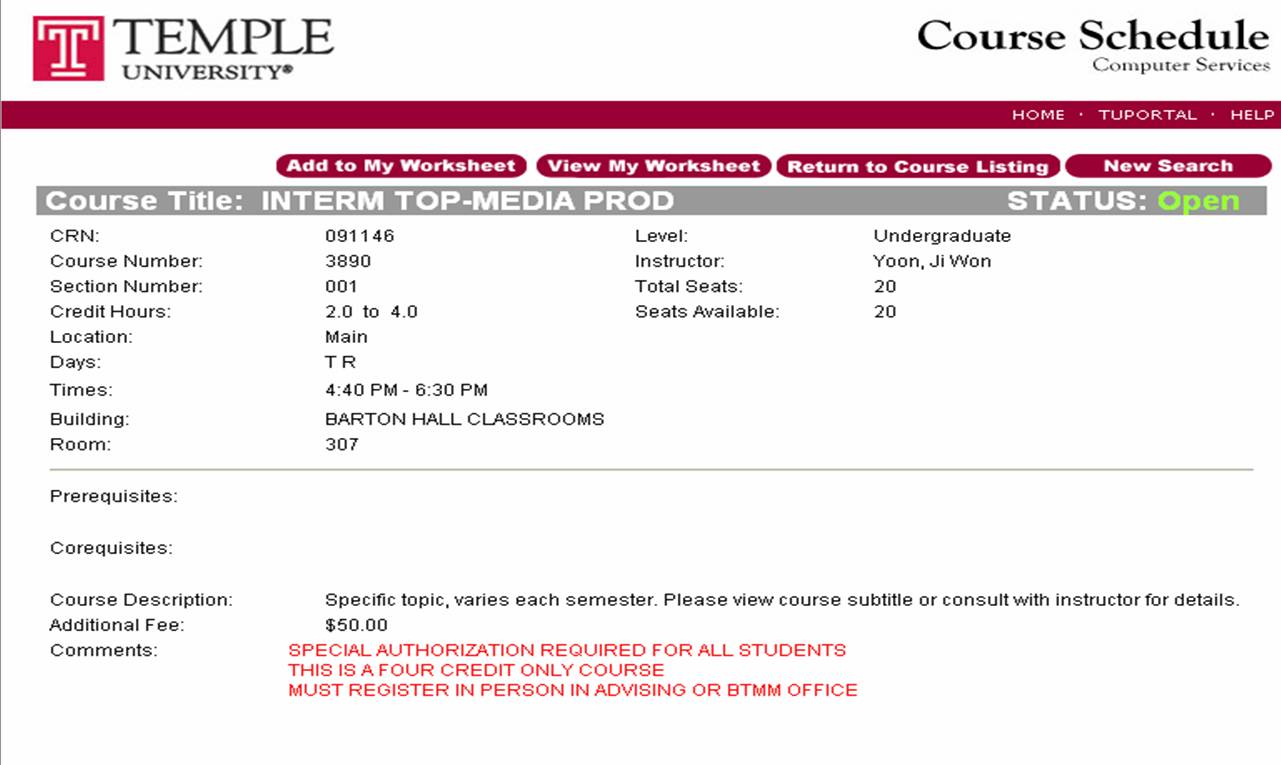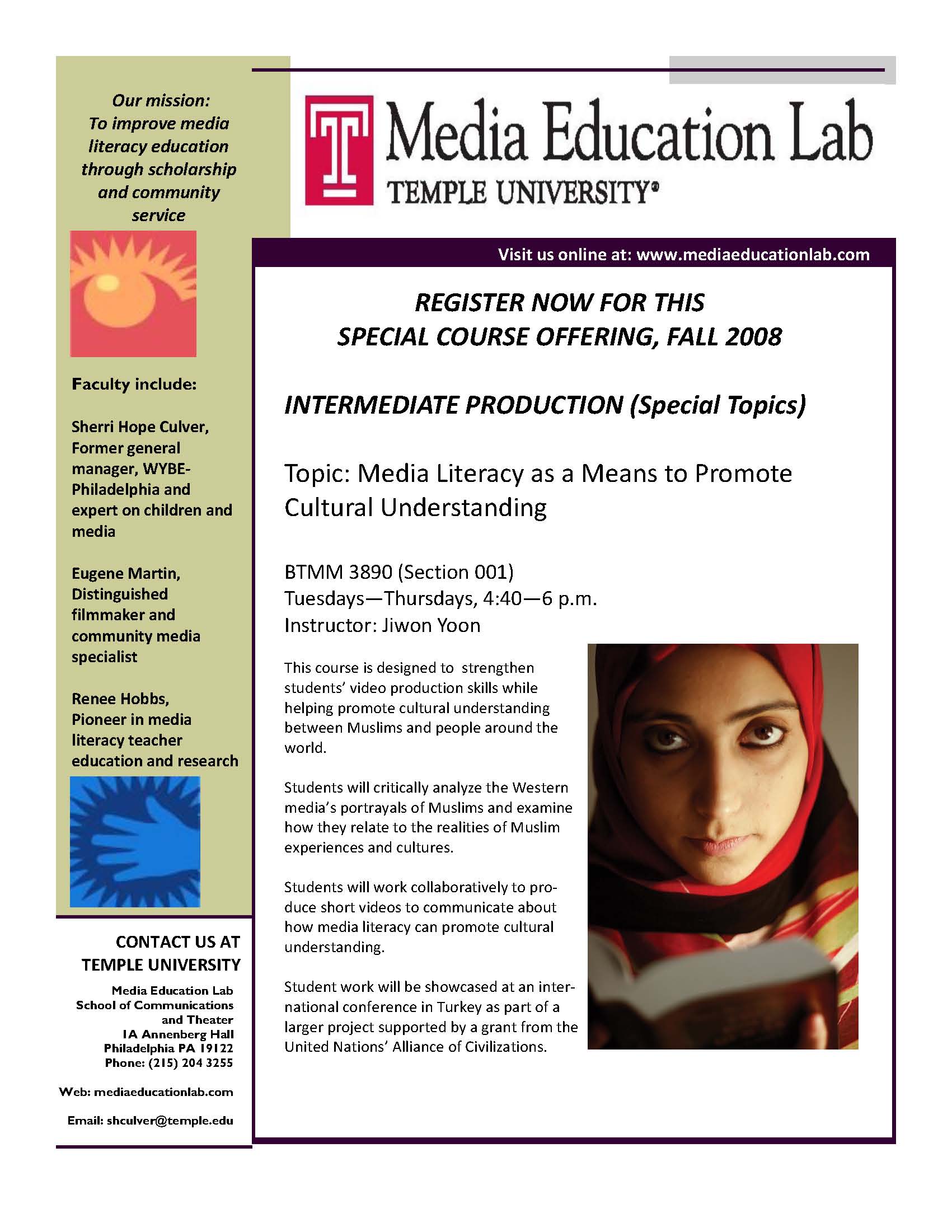Henry Jenkins 같은 분도 과에서 원하는 걸 얻지 못해서, 결국 자신의 뜻을 펼칠 수 있는 곳으로 옮기네요. MIT 와 USC 의 미래가 궁금해지네요.
http://chronicle.com/wiredcampus/index.php?id=3528&utm_source=wc&utm_medium=en
http://rekha6.wordpress.com/2008/12/16/the-importance-of-media-education-an-open-letter-to-mit/
http://chronicle.com/wiredcampus/article/?id=3468
저희가 신경을 쓰지 못하는 중에도 꾸준히 들어오시는 분들이 계시는 거 같아 뭔가 올려야 한다는, 올리고 싶다는 생각이 계속 들었는데, 제가 다니는 학교 가까이 있는 유펜에서 재밌는 걸 했길래 이렇게 링크를 올려봅니다.
도서관에서 주체한, 비디오 Mashup 이에요. 기존의 비디오텍스트를 가지고 학생들이 새로운 메시지를 만들어 냈어요. 아이들과 해보기 좋은 exercise 가 아닐까 싶습니다.
http://wic.library.upenn.edu/mashup/2009voting.html
목차:
1. 멀티플미디어 리터러시의 등장배경 및 필요성
2. 해외 미디어 리터러시 현황 분석
3. 해외 현황에서 본 미디어 리터러시에 관한 시사점
4. 우리나라 멀티플미디어 리터러시 추진방향 제언
5. 결언
+++
저도 아직 자세히는 못 읽어봤는데요. 교육 분야가 아닌 인터넷/테크놀로지 분야에서 멀티
리터러시에 어떻게 접근하고 있는지를 살펴볼 수 있는 보고서 일 것 같아,
첨부해봅니다.


저희 연구실에서 United Nations’ Alliance of Civilizations 에서 intercultural understanding 을 도모할 수 있는 미디어 교육 커리큘럼을 만들라고 작은 펀드를 받았는데 결국은 제가 그 짐을 지고 수업을 가르치게 되었습니다. 구체적으로 모슬림과 서양의 문화라는 구체적인 지시가 있었고요, 제가 담학기 이 수업가르치는 동안 터키에서도 동시에 수업 진행됩니다.
사실 대학에서는 처음 가르쳐 보는 거라서 떨리기도 하고, Renee 교수님께서 너무 기대하시면서 요즘 연구실에 오는 사람들마다 이 이야기 하셔서 부담도 엄청 됩니다. 제가 3월 27일부터 4월 9일까지 졸업시험이 잡힌데다가 끝나고 나서 5월 초까지 논문 프로포절을 써야 여름에 한국에 갈 수 있는 상황이여서 수업준비는 전혀 안된 상태에요. 여름에 Renee 교수님이랑 차분히 같이 준비하면 좋을텐데, 제가 한국에 가버리니 그럴 수가 없어 더욱 걱정입니다.
하지만 그것보다 더 떨리는 건 아이들이 수강신청 하지 않아서 폐강되는 거에요. 사실 그동안 TA 는 계속 했지만 가르치는게 처음인지라 강의평가 받은 것도 없고, 절 모르는 학생들이 훨씬 더 많은 상황에서 과연 충분한 수의 학생들이 신청을 할지 두근두근....
사실 매 학기 폐강되는 수업들이 제법 많은 편인지라 많이 떨리네요.
처음 강의하려니까 여러가지로 긴장이 참 많이 되는 거 같아요.
혹시 좋은 아이디어, 자료들 있음 많이들 나눠주시구요,
앞에도 썼지만 전 코앞으로 다가온 종합시험때문에 당분간 연락이 힘들수도 있을 거 같아요. 체질적으로 벼락치기를 잘 못하는데, 이렇게 큰 시험을 벼락치기 할줄은 몰랐네요. 박사과정 2년 반동안 공부한 내용들을, 요즘 완전 초치기로 정리하면서 시험 준비하고 있습니다.
http://cafe.daum.net/gsstm
그리고 강서영상미디어센터에서 새터민 대상 미디어교육이 있다고 하는데, 관련 자료는 아래에 있습니다.
한국예술종합학교에서 새로운 랩을 만드는데 연구원을 초빙하는 공고입니다.
그중에 미디어교육 관련한 항목이 있어 눈길이 가네요.
일본 도쿄대학의 정보학환 등에 대해서도 벤치마킹을 하고, 미디어 아트에 대해서도 큰 국제 심포지엄을 하면서 여러가지로 분주히 움직이더니 본격적인 연구를 하려나봅니다.
어떤 움직임이 있는 것인지 알아가는 차원에서라도 관심을 가져보면 좋겠죠?
http://www.mct.go.kr/web/notifyCourt/notice/mctNoticeView.jsp?pCurrentPage=1&pSeq=3745
English and Media Centre 홈페이지 링크입니다.
무엇보다도 꾸준히 업데이트 되는 교재들과 교사 연수 프로그램의 소개를 볼 수 있다는 것이 매력적인 싸이트입니다.
http://www.englishandmedia.co.uk/index.html
EMC Publications 섹션에 가보시면 2008년 Educational Resource Awards 의 후보로 선정된 새교재 English All Sorts 의 샘플을 다운 받으실 수 있습니다.
홈페이지에 실린 English All Sorts의 짧은 소개글입니다:
A compendium of strategies to engage and challenge students from 11 to 18, drawing on over 30 years of the English and Media Centre’s work with teachers – all sorts of ideas for good, fun, do-able classroom activities.
Multimodal Literacies
A summary statement developed by the Multimodal Literacies Issue Management Team of the NCTE Executive Committee
Approved by the NCTE Executive Committee, November 2005
"Has there ever been a time when we have not been awash in a remarkable torrent of symbols and opportunities for reading and writing them?" (William Kist )
http://www.ncte.org/about/over/positions/category/media/123213.htm
Declarations concerning the broadest definitions of multimodal literacies:
-
Integration of multiple modes of communication and expression can enhance or transform the meaning of the work beyond illustration or decoration.
What this means for teaching:-
It is the interplay of meaning-making systems (alphabetic, oral, visual, etc.) that teachers and students should strive to study and produce. "Multiple ways of knowing" (Short & Harste) also include art, music, movement, and drama, which should not be considered curricular luxuries.
-
All modes of communication are codependent. Each affects the nature of the content of the other and the overall rhetorical impact of the communication event itself.
-
-
Young children practice multimodal literacies naturally and spontaneously. They easily combine and move between drama, art, text, music, speech, sound, physical movement, animation/gaming, etc.
What this means for teaching:
-
Children who grow up in impoverished or repressed literacy environments may not experience this important early literacy foundation.
-
The over-emphasis on testing and teaching to the test may deprive many students of the kinds of multimodal experiences they most need.
-
An exclusive emphasis on digital literacies is not what most advocates of technology-rich composition advocate. Such an emphasis would limit students' access to other modes of expression.
-
The use of different modes of expression in student work should be integrated into the overall literacy goals of the curriculum and appropriate for time and resources invested.
What this means for teaching:
-
"Students should be able to both read critically and write functionally, no matter what the medium" (William Kist). In personal, civic, and professional discourse, alphabetic, visual, and aural works are not luxuries but essential components of knowing.
-
Because of the complexity of multimodal projects and the different levels of skill and sensitivity each individual brings to their execution, such projects often demand high levels of collaboration and teamwork.
What this means for teaching:
-
Teachers of the English/Language Arts already have models for this type of collaboration, such as those for producing a play. Any dramatic production includes speech, movement, costumes, props, sets, lighting and, sometimes, music and dance. Beyond the performance itself is the need for producing appealing programs and advertising. And, beyond that are the persuasive verbal skills needed to raise funds to produce the production.
-
Other kinds of more traditional multimodal projects also require this type of collaboration. When students produce brochures, literary magazines, books, videos, or greeting cards, collaboration improves the product and helps all students involved learn more.
-
The use of multimodal literacies has expanded the ways we acquire information and understand concepts. Ever since the days of illustrated books and maps texts have included visual elements for the purpose of imparting information. The contemporary difference is the ease with which we can combine words, images, sound, color, animation, video, and styles of print in projects so that they are part of our everyday lives and, at least by our youngest generation, often taken for granted.
What this means for teaching:
-
Readers in electronic environments are able to gain access immediately to a broad range and great depth of information that not 15 years ago would have required long visits to libraries or days of waiting for mailed replies.
-
The techniques of acquiring, organizing, evaluating, and creatively using multimodal information should become an increasingly important component of the English/Language Arts classroom.
- From an early age, students are very sophisticated readers and producers of multimodal work. They can be helped to understand how these works make meaning, how they are based on conventions, and how they are created for and respond to specific communities or audiences.
What this means for teaching:
- Students should be invited to collaborate with their teachers in the study of new literacies and in the practical aspects of integrating those literacies into the curriculum.
-
The additional dimensions of multimodal work add increased complexity to the tasks of teaching, learning, and, therefore, the evaluation of those learning experiences.
What this means for teaching:
-
The complexity of multimodal work suggests that an assessment process must be developed and refined collaboratively by students, teachers, administrators, parents, and other stakeholders over time.
-
Goals and criteria need to be clear to all from the beginning of the work.
-
The difficulty of grading the work using traditional methods may prevent some teachers from attempting this kind of work.
Declarations concerning the unique capacities and challenges of digital forms:
-
There are increased cognitive demands on the audience to interpret the intertextuality of communication events that include combinations of print, speech, images, sounds, movement, music, and animation. Products may blur traditional lines of genre, author/audience, and linear sequence.
What this means for teaching:
What this means for teaching:
-
Students may find school instruction increasingly irrelevant (National Educational Technology Plan).
-
Educators will have to devise ways of including students who are advanced technology practitioners in the development of curricula, professional development experiences, teacher recruiting, and the setting of relevant policies.
-
Implications of the digital divide. Institutions and teachers must create ways to bridge the digital divide, providing access and resources for all students. More specifically, "for students [and teachers] we need to provide adequate, safe, and supported work time" (Dickie Selfe). "We must call on our institutions to provide the necessary support and infrastructural, cultural, and technological adjustments, including access to technology for people with diverse abilities and needs" (BETHA group).
- Creating images, sounds, designs, videos and other extra-alphanumeric texts is an aesthetic, self-originated, self-sponsored activity for many writers. Digital technologies have increasing capacity for individuals to adapt the tools for their own information and communication purposes. Students have the capability to apply literacy skills to real world problems and knowledge building. They are able to exercise creativity, work for social justice, and pursue personal passions (CCCC Feb. 2004 position statement). They have the means to publish their work to a global audience.
What this means for teaching:
-
Young people are particularly adept at recognizing creative applications for new technologies, but their in-school work should be guided by the wisdom and sophisticated curricular knowledge of their teachers. In addition, they need direct instruction in ethical, critical, and legal considerations.
-
Students and teachers will need assistance in the skills of multitasking, accessing “just in time” information, problem solving, and prioritizing tasks and resources to accomplish the goals of their assignments.
-
Their work may at times be more like that of the workplace than that of the traditional classroom.
-
With more opportunities and greater ease in sending their work out into the world, the quality of the ideas and the effectiveness of the communication media will become more important and more relevant to students.
-
With the development of multimodal literacy tools, writers are increasingly expected to be responsible for many aspects of the writing, design, and distribution processes that were formerly apportioned to other experts.
What this means for teaching:
-
While digital publishing is often immediate and of an ephemeral nature, the writer loses control over the work and its potential audience in a way that wasn't as true in print publishing. This will blur and complicate ethical issues of ownership, plagiarism, and authenticity.
-
Teachers will need to "master technologies enough to guide students in the ethics underlying their use" (Dene Grigar).
1979년부터 2007년까지 BFI 교육 파트를 이끌면서 미디어 교육과 관련된 여러가지 연구와 교재 개발 등의 활동을 한 Cary Bazalgette 의 블로그입니다.
Research 섹션에 가보시면 최근에 발표된 BBC 뉴스 제작 교육의 효과에 대한 연구 보고서가 올라와있습니다. 흥미로운 자료입니다. 시간 나실때 꼭 한번 찾아보시길..
 invalid-file
invalid-file invalid-file
invalid-file

